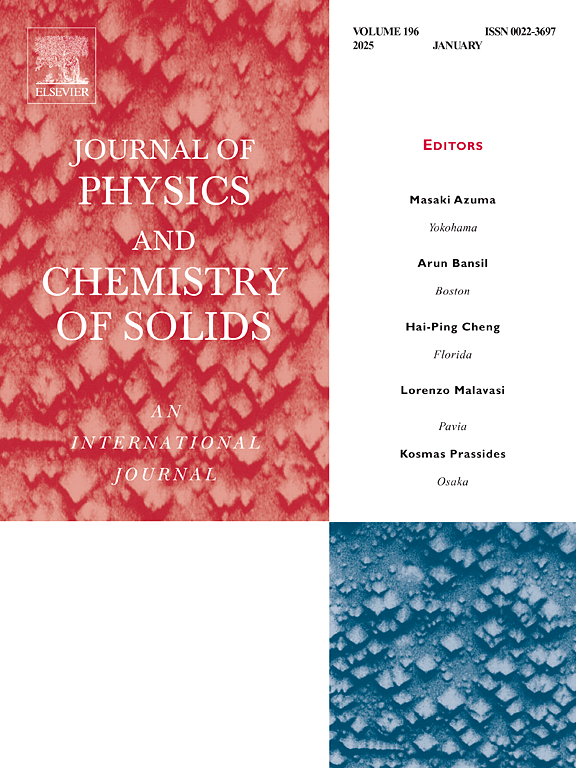Improved electrochemical performance of tri metallic-organic framework decorated with graphene oxide sheets for high-performance energy storage applications
IF 4.9
3区 材料科学
Q2 CHEMISTRY, MULTIDISCIPLINARY
引用次数: 0
Abstract
The recent progress in development of metal-organic frameworks (MOFs) have gathered significant interest for their application in the invention of supercapacitors owing to their large surface area and substantial absorbency. Though, inadequate ability to conduct electricity as well as suboptimal mechanical features of the MOFs constrained its applicability within the field. Therefore, tri-metallic MOF with graphene oxide (Ni-Mg-Mo-MOF@GO nanocomposite) was synthesized to improve the weak characteristics of MOF. The CV measurement revealed a specific capacitance of 14125 F/g in a system consisting of three electrodes with an electrolyte of 1 M KOH at a scan rate of 10 mV/s when the Ni-Mg-Mo-MOF@GO nanocomposite was utilised as the conducting electrode component for a supercapacitor. Ni-Mg-Mo-MOF@GO/carbon active/accumulated in 1 M KOH electrolyte solution inside a potential window range of 0.75V demonstrate excellent energy storage ability due to the synergistic interaction between graphene oxide. In GCD analysis Ni-Mg-Mo-MOF@GO had the largest specific capacitance with a power density of 561Wkg–1 and a current density of 1.33Ag–1. This study confirms that Ni-Mg-Mo-MOF@GO increases both capacitive and diffusive controlled current contribution process respectively. Electrochemical outcomes demonstrate that this nanocomposite's enhance super-capacitive performance. Consequently, for high energy storage applications, this nanocomposite may be an ideal electrode material.
以氧化石墨烯片装饰的三金属-有机框架在高性能储能应用中的电化学性能改善
金属有机骨架(MOFs)由于具有较大的表面积和良好的吸光性,近年来在超级电容器领域的应用引起了人们的极大兴趣。然而,mof的导电能力不足以及不理想的机械特性限制了其在该领域的适用性。因此,合成了氧化石墨烯纳米复合材料(Ni-Mg-Mo-MOF@GO纳米复合材料)来改善MOF的弱特性。当使用Ni-Mg-Mo-MOF@GO纳米复合材料作为超级电容器的导电电极组件时,CV测量结果表明,在扫描速率为10 mV/s的扫描速率下,由三个电极组成的系统中,比电容为14125 F/g。Ni-Mg-Mo-MOF@GO/碳活性/在0.75V的电位窗口范围内积累在1 M KOH电解质溶液中,由于氧化石墨烯之间的协同相互作用,表现出优异的储能能力。在GCD分析中,Ni-Mg-Mo-MOF@GO的比电容最大,功率密度为561Wkg-1,电流密度为1.33Ag-1。该研究证实Ni-Mg-Mo-MOF@GO分别增加了电容和扩散控制的电流贡献过程。电化学结果表明,该纳米复合材料提高了超电容性能。因此,对于高能量存储应用,这种纳米复合材料可能是一种理想的电极材料。
本文章由计算机程序翻译,如有差异,请以英文原文为准。
求助全文
约1分钟内获得全文
求助全文
来源期刊
CiteScore
7.80
自引率
2.50%
发文量
605
审稿时长
40 days
期刊介绍:
The Journal of Physics and Chemistry of Solids is a well-established international medium for publication of archival research in condensed matter and materials sciences. Areas of interest broadly include experimental and theoretical research on electronic, magnetic, spectroscopic and structural properties as well as the statistical mechanics and thermodynamics of materials. The focus is on gaining physical and chemical insight into the properties and potential applications of condensed matter systems.
Within the broad scope of the journal, beyond regular contributions, the editors have identified submissions in the following areas of physics and chemistry of solids to be of special current interest to the journal:
Low-dimensional systems
Exotic states of quantum electron matter including topological phases
Energy conversion and storage
Interfaces, nanoparticles and catalysts.

 求助内容:
求助内容: 应助结果提醒方式:
应助结果提醒方式:


